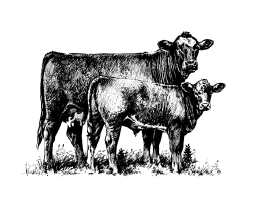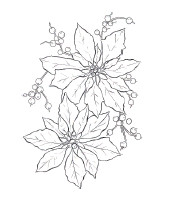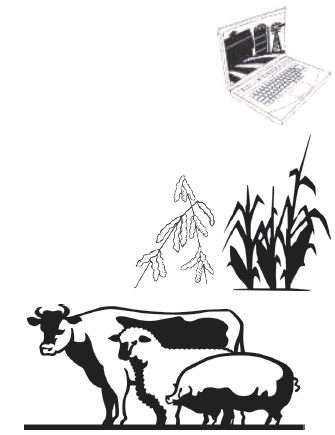

To send a message to an author, click on the author's name at the end of the article.
This Month in Ag Connection | Ag Connection - Other Issues Online
As temperatures continue to drop winter management practices become more important for the beef cow herd. For many producers in northeast Missouri calving season is just around the corner and keeping cows in the correct body condition score (BCS; 5-6) will benefit productivity.

With declining temperatures the energy requirement for animal maintenance and production increase, therefore taking steps to minimize those affects is important. Wind breaks can greatly impact productivity by providing shelter from the wind and winter elements. Wind breaks can cause snow to drift in a desired direction instead of covering desirable forage and allowing for greater mobility. Planting multiple rows of trees 50 to 100 feet up wind will provide enough distance to slow wind and shift drifting in a preferable direction. Portable calf shelters can have extended walls providing a wind break for the herd and can be moved to other locations.
Bedding is very important in reducing the effect of cold stress on cattle and provides a dry clean place for calving. Do not forget to provide bedding for bulls to avoid breeding soundness issues caused by frostbitten testicles.
Cows starting the winter in good condition, BCS 5-6, will have a better chance of making it through winter in good condition. Cold stressed cattle could have increased feed consumption as much as 5-25% due to increased energy requirements. Feeds should be highly digestible and of good quality. If stored hay or stockpiled forage is of lower quality, consider supplementing with a concentrate.
Other considerations for cold weather management include:
Source: Daniel Mallory, Livestock Specialist
This Month in Ag Connection | Ag Connection - Other Issues Online
The following tips will help care for indoor plants during the holiday season and ensure outdoor plants are protected from winter's fury.

Source: Jennifer Schutter, Horticulture Specialist
This Month in Ag Connection | Ag Connection - Other Issues Online
Hog and pig farming is a $22.5 billion industry, up 25% since 2007. In 2012, independent growers operated 85% of hog and pig farms, accounting for 46% of the 199.1 million hogs and pigs sold. Missouri ranks 7th in the nation for hogs and pigs sold and are the number four agricultural product within Missouri.
Artificial insemination is a well-established technique used on commercial swine farms but may be a new tool for smaller hog producers with less than 10 breeding females. Artificial insemination can be successful on any size farm with proper management.
Swine estrous cycle: The pig estrous cycle averages 21 days but can range from 17-25 days. The 2-3 days the female is receptive to the male and will stand to be mounted is referred to as standing heat and termed estrus.
Estrus (heat) detection: The importance of accurate heat detection cannot be overemphasized and is vital to the success of each breeding. Heat detection is more successful when checking two times per day at 12 hour intervals. If one time per day detection is chosen, checking should be done in the morning before feeding or at least one hour following feeding. Boar exposure is essential to initiate the standing response and is stimulated by exposure to the boar's pheromones released from the submaxillary salivary glands. These glands mature around 10 months of age. Synthetic products are available if a boar is not present on the farm. In the presence of a boar or with use of a synthetic product, females should stand for applied pressure to the back. Stimulate or rub the flank, back, and neck of the female during detection and while inseminating. Other signs of heat include: mounting or attempting to ride other females, erect "popping" ears,
red and swollen vulva, mucous discharge, and increased vocalization and activity. Females should be inseminated once daily each day they stand. If heat checking two times per day, inseminate gilts 12 hours after standing heat is detected and 24 hours for sows. If heat detection is done one time per day, inseminate at time of detection and every day she continues to stand.
Inseminating the female:
For more information contact your livestock specialist or access MU Guide G2312 online (http://extension.missouri.edu/p/G2312) or through your local extension office.
Source: Heather Smith, Livestock Specialist
This Month in Ag Connection | Ag Connection - Other Issues Online
There are several changes and resources producers need to be aware of for the 2014 tax year. The following are a few highlights:
Farm Repairs: The IRS has made some clarification as to what is a repair. A repair is defined as: "to restore to a sound state and to keep the property in operating condition during its useful life." Repairs are generally expensed in the year purchased. An improvement is defined as: "something that results in the betterment, prolonging the life, restoration or adaptation to a different use of a unit of property." Improvements must be capitalized over the useful life of the asset. For example, an engine overhaul would be viewed as prolonging the life and thus should be capitalized. Anything that includes both types must be split and handled accordingly. For example, a farmer purchases a grain truck with a broken light. He fixes the light and paints the farm logo on the cab of the truck. The light is a repair and expensed, while the logo painting is considered an improvement and must be capitalized. Businesses {farmers included} can adopt "safe harbor" rules for repairs of up to $5,000 if they submit a qualified financial statement with their income tax return for 2014.
Veterinarians: An IRS chief counsel ruling determined that veterinarians are providing medical and healthcare services, therefore, veterinarians {including incorporated ones} are subject to the 1099 rules. If a veterinarian is paid over $600 in a tax year for services {medicines and supplies are separate} then a 1099 MISC form must be sent to them by January 31st. Section 179 Expense: The allowable amount expensed under Section 179 has been lowered to $25,000 at this time, a major drop from 2013 when it was $500,000.
Section 179 has been a tool for managing taxable income. This is a great asset for farmers since income is typically not known until later in the year. Another change is the additional 1st year depreciation which has helped producers put up hay and machinery sheds has expired. Many tax professionals expect the new Congress to readdress both of these issues in the next two months; therefore, it is important to keep updated.
Income tax resources: The University of Missouri Extension Office in your county has several tax resources. Some of these resources will be available by the end of December. These resources include:
Source: Joe Koenen, Ag Business Specialist

This Month in Ag Connection | Ag Connection - Other Issues Online
Farm Bill Meetings to be held in December through January at Various Locations throughout Northeast Missouri for more information and details contact:
Darla Campbell, phone: 660-457-3426, email: campbell@missouri.edu
Karisha Devlin, phone: 660-397-2179, email: devlink@missouri.edu
Joe Koenen, phone: 660-947-2990, email: koenenj@missouri.edu
Mary Sobba, phone: 573-581-3231, email: sobbam@missouri.edu
Missouri Crop Management Conference
December 17 & 18, 2014
Holiday Inn Select - Columbia, MO 65203
website: http://plantsci.missouri.edu/cmc/
Computers on the Farm Conference
January 9 & 10, 2014
Tan-Tar-A Resort, Osage Beach, MO
website: http://agebb.missouri.edu/cotf/
Publishing Information
Ag Connection is published monthly for Northeast and Central areas of Missouri producers and is supported by the University of Missouri Extension, the Missouri Agricultural Experiment Station, and the MU College of Agriculture, Food and Natural Resources. Managing Editor: Mary Sobba.